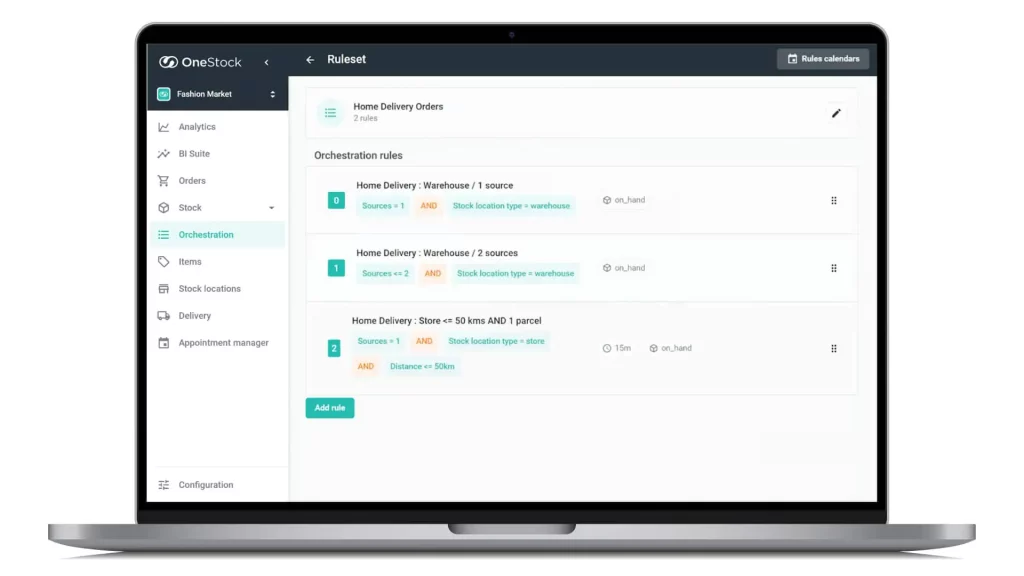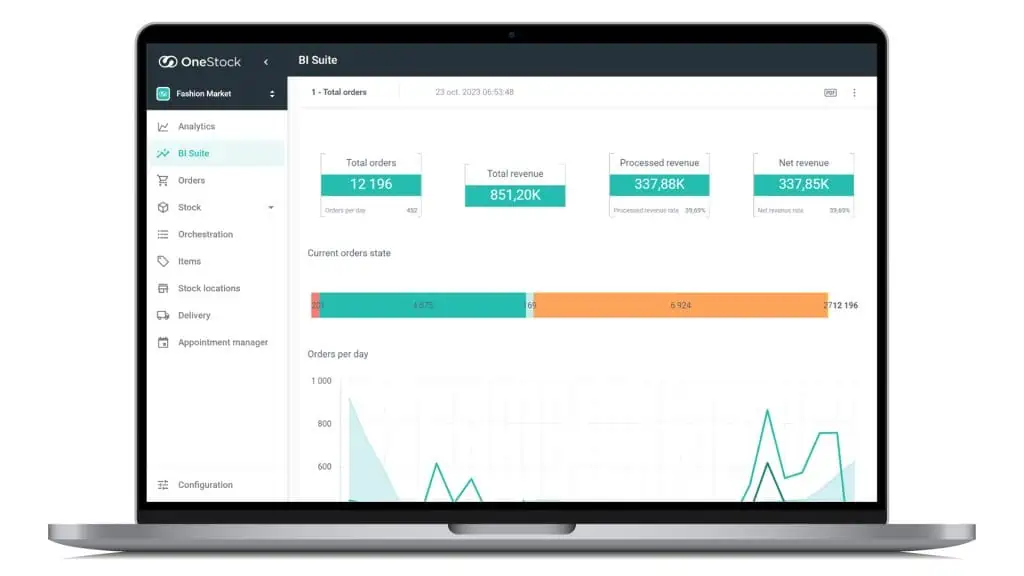
Order management software: powering efficient business operations
The efficient management of orders is paramount to success. Gone are the days when manual processes and spreadsheets sufficed. Enter order management software: a digital solution that has revolutionised the way businesses handle their orders.
This comprehensive article explores the world of order management software, its core functionalities, analytics capabilities, deployment options, real-world case studies, and the future innovations that promise to reshape the industry. Additionally, we’ll delve into best practices and common pitfalls to help you make informed decisions in your pursuit of efficient order management.
Table of contents
Why every business needs order management software
The digital transformation of order processes
Beyond spreadsheets: the rise of automated systems
Inside the core functions of order management software
From order creation to fulfilment: a lifecycle overview
Integrations: playing well with other systems
The role of analytics in order management
Gaining real-time insights
Predictive analysis for inventory management
Tailoring your solution: SaaS vs on-premises
The flexibility and scalability of cloud-based solutions
Security and customisation in on-premises deployments
Case studies: businesses transformed by Order Management Systems
Small businesses scaling with digital solutions
How large enterprises streamline complex operations
Navigating the market: how to choose your platform
Essential features checklist for buyers
User reviews and trustworthiness in selection
The future outlook: innovations in order management
AI and machine learning enhancements
The growing importance of omnichannel solutions
Lessons learned: best practices and common pitfalls
Success stories and lessons from early adopters
Avoiding common mistakes in system deployment
Why every business need order management software?
The digital transformation of order processes
Commerce has witnessed a significant shift towards digitisation across various business functions, and order management is no exception. Traditional manual processes have proven to be error-prone, time-consuming and inefficient. Order management software offers a streamlined solution that digitises and automates critical order-related processes, from order creation to fulfilment.
Beyond spreadsheets: the rise of automated systems
Many businesses still rely on spreadsheets and manual data entry for order management, leading to inefficiencies and costly errors. Order management software replaces these outdated methods with automated systems that can handle a vast volume of orders with precision. It eliminates the need for manual data entry, reducing the risk of human error and saving valuable time that can be redirected toward more strategic tasks.

Inside the core functions of order management software
From order creation to fulfilment: a lifecycle overview
Order management software encompasses a wide range of functions. It starts with order creation, where customers place orders through various channels, such as e-commerce websites, mobile apps, marketplaces, or even in-store. From there, the software facilitates order tracking, inventory management and seamless order fulfilment. It also handles returns and exchanges, providing a smooth end-to-end customer experience.
Because every business has different needs throughout the order lifecycle, OneStock’s order management software is highly customisable. Business users can create custom workflows, rules and notifications to adapt order processes to changing customer expectations, business objectives and industry trends. These intelligent workflows and algorithms allow OneStock to excel in omnichannel order management, enabling brands to deliver a consistent shopping experience across online and offline channels.
Integrations: playing well with other systems
In today’s interconnected business landscape, integration capabilities are paramount. Order management software acts as a central hub, seamlessly connecting other business critical systems like inventory management, customer relationship management (CRM) and accounting software. This ensures data consistency across the organisation, enabling better decision-making and a more synchronised operation.
For ease of integration, businesses should ensure the technologies they implement are MACH-certified. This enables a modular ecosystem where businesses have the freedom to select the best tools on the market and add, replace or remove technologies according to customer and commercial needs.
The role of analytics in Order Management
Gaining real-time insights
One of the standout features of order management software is its analytics capabilities. Businesses can access real-time insights into order trends, customer behaviour and inventory levels, all of which contribute to more informed business strategies. These insights enable businesses to adapt quickly to changing market conditions and customer demands, giving them a competitive edge.

Predictive analysis for inventory management
Predictive analysis is another valuable tool offered by order management software. By analysing historical data and current trends, businesses can forecast demand, optimise inventory levels and reduce carrying costs. This proactive approach prevents stockouts and overstock situations, ultimately improving customer satisfaction and profitability.
OneStock’s order management software includes robust analytics and reporting capabilities by default in its user licensing. An additional high-level product called the Business Intelligence Suite is also available to share an even more exhaustive view of an organisation’s omnichannel activity.
Tailoring your solution: SaaS vs on-premises
The flexibility and scalability of cloud-based solutions
Order management software comes in two primary deployment options: Software as a Service (SaaS) and on-premises solutions. Cloud-based SaaS solutions offer flexibility and scalability, allowing businesses to pay for what they use and easily scale up or down as needed. The cloud-based nature of SaaS also ensures accessibility from anywhere with an internet connection, making them ideal for businesses with multiple locations.
Security and customisation in on-premises deployments
On the other hand, on-premises deployments provide businesses with full control over their data and infrastructure. This level of control can be advantageous for companies with specific security requirements or highly customised processes. However, it comes with higher upfront costs and ongoing maintenance responsibilities.
Case studies: businesses transformed by Order Management Systems
Businesses scaling with digital solutions
Many businesses with ambitions for growth have found order management software to be a game-changer. It enables them to compete with larger competitors by increasing sales opportunities, streamlining operations, improving order accuracy and enhancing the customer experience.
These examples that showcase how businesses have scaled and thrived with the help of our digital solutions:
- A 200% increase in online sales in only 9 months for Intersport
- Click and Collect orders can be prepared in just 30 minutes at Pets at Home
- 30% of global sales are generated by e-commerce activity at Petit Bateau
How large enterprises streamline complex operations
Large enterprises face the challenge of managing a high volume of orders across an intricate supply chain made up of numerous channels and locations. These businesses can benefit immensely from order management software, which centralises control of inventory, simplifies complex order processes, reduces costs and increases overall operational efficiency.
Consider industry giants with vast networks of warehouses and suppliers across multiple geographies:
- Better delivery promise control to accelerate sales growth at ManoMano
An Order Management System offers benefits for every business, regardless of size or sector: Explore all our customer stories
Navigating the OMS market: how to choose your platform
In the highly competitive landscape of order management software, OneStock stands out as the leading solution for its comprehensive suite of features and proven track record.
Essential features checklist for buyers
Selecting the right order management software is a critical decision. To aid in this process, we’ve created an essential features checklist that prospective buyers should look for. These include order tracking, inventory management, reporting capabilities, integration options and scalability.
Download our RFP template with a checklist of over 100 questions to ask when considering a new OMS provider.
User reviews in selection
In addition to feature considerations, user reviews and vendor trustworthiness play a crucial role in the selection process. Real-world experiences and feedback from existing users can provide valuable insights into the usability and reliability of a particular order management software solution.
Reach out to businesses similar to yours that have implemented the software to gather firsthand feedback.
The future innovations in order management
AI and machine learning enhancements
As technology continues to advance, order management software is evolving with the integration of artificial intelligence (AI) and machine learning (ML). These enhancements promise to further optimise processes, enable predictive analytics and enhance customer experiences through intelligent automation.
The growing importance of omnichannel solutions
As customers increasingly expect a seamless shopping experience across multiple channels, the importance of omnichannel order management solutions will continue to rise. These solutions unify online and offline sales channels, enabling businesses to provide a consistent experience across all touchpoints. With the ability to track inventory in real time and fulfil orders from any location, businesses can meet customers’ demands for convenience and flexibility.
Lessons learned: best practices and common pitfalls
Success stories and lessons from early adopters
To succeed with order management software, it’s essential to learn from the experiences of early adopters. Many businesses have already reaped the benefits of efficient order management. Their success stories highlight the importance of embracing technology to streamline operations, reduce errors and boost customer satisfaction.
Avoiding common mistakes in system deployment
While the benefits of order management software are undeniable, it’s crucial to avoid common pitfalls during system deployment. Some of these include inadequate staff training, poor data migration and underestimating the need for ongoing support. Businesses should invest time and resources into proper training to ensure a smooth transition when implementing new software.
Order management software is the driving force behind efficient and competitive business operations in the digital age. Its ability to streamline order processes, provide real-time insights and adapt to changing market dynamics can make a significant impact on your bottom line.
By embracing order management software like OneStock, businesses can unlock new levels of efficiency, customer satisfaction and profitability, positioning themselves for success in omnichannel commerce.


